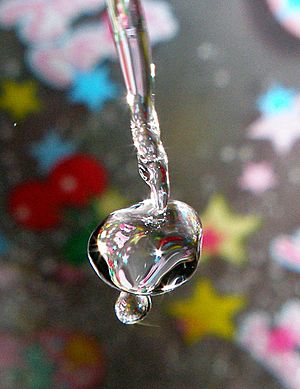Mizuame facts for kids
 |
|
| Type | Sweetener |
|---|---|
| Place of origin | Japan |
| Main ingredients | Glutinous rice and malt or potatoes |
Mizuame (水飴, literally "water candy", also known as millet jelly) is a special kind of sweetener from Japan. It looks like a clear, thick, and sticky liquid. Think of it like a very thick syrup!
Mizuame is made by changing starch into sugars. It is often used in Japanese sweets called wagashi to make them look shiny. People also enjoy Mizuame in ways similar to how we use honey, or it can be a main part of other yummy treats. Some types of Mizuame taste and are made very much like corn syrup.
Contents
What is Mizuame?
Mizuame means "water candy" in Japanese. It is a traditional Japanese syrup that has been made for a very long time. It's known for its clear look and sticky texture. This sweet syrup is a popular ingredient in many Japanese desserts.
How is Mizuame Made?
Mizuame is made by changing starches into sugars. There are two main ways to do this:
Traditional Method: Using Rice and Malt
The older, traditional way to make Mizuame uses glutinous rice and malt. Here's how it works:
- First, glutinous rice is mixed with malt.
- Then, natural enzymes (special proteins that speed up reactions) in the malt start working.
- These enzymes break down the starch in the rice.
- This process turns the starch into a sweet syrup.
- This syrup is mostly made of a sugar called maltose.
- Mizuame made this way is called mugi mizuame (麦水飴). Many people think it has a richer and more interesting flavor.
Modern Method: Using Potatoes and Acid
The second, more common way to make Mizuame uses potato starch or sweet potato starch. This method is called acid hydrolysis.
- Acids like hydrochloric, sulfuric, or nitric acid are added to the potato starch.
- These acids help to break down the starch very quickly.
- This process creates a syrup that is mainly glucose syrup.
- This method is faster and often used for making larger amounts of Mizuame.
How is Mizuame Used?
Mizuame is a versatile sweetener in Japan. It's used in many different ways:
- In Wagashi: It gives traditional Japanese sweets a beautiful, glossy finish.
- As a Topping: You can drizzle it over pancakes, toast, or desserts, just like honey or maple syrup.
- In Candies: It's a key ingredient in many Japanese candies and sweets, giving them a chewy texture.
- For Cooking: It can be used in cooking to add sweetness and moisture to dishes.
See also
 In Spanish: Mizuame para niños
In Spanish: Mizuame para niños

